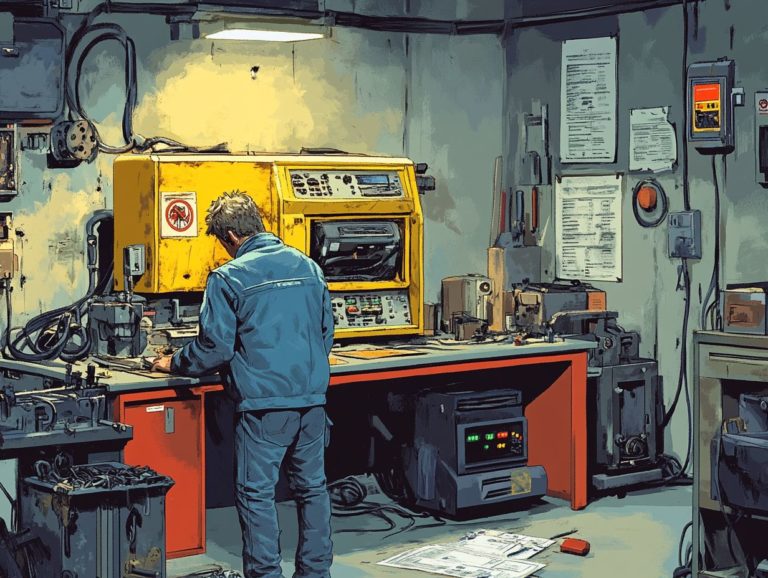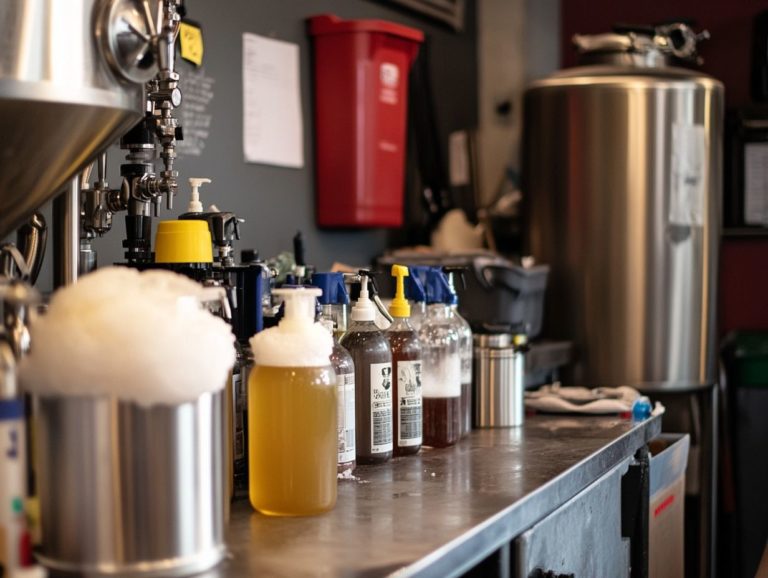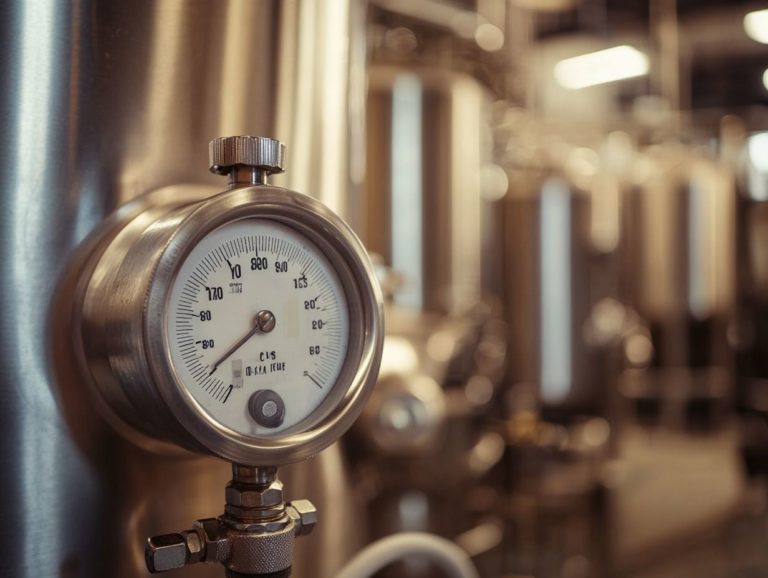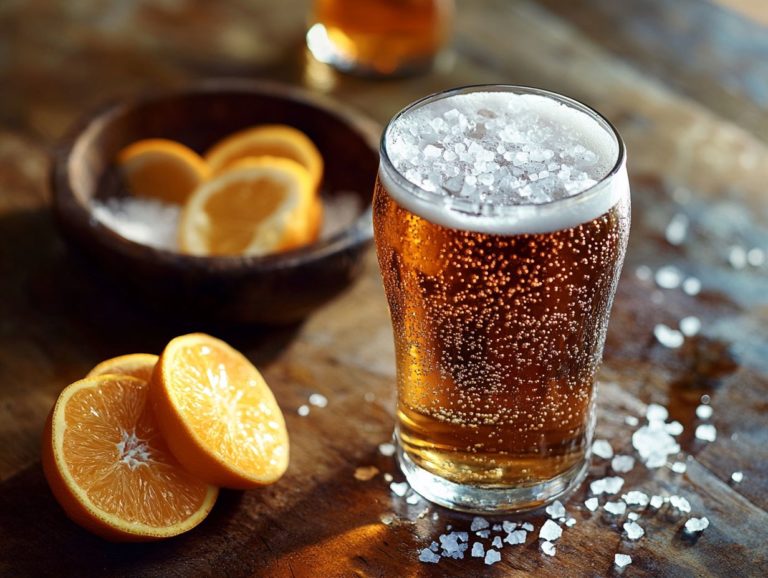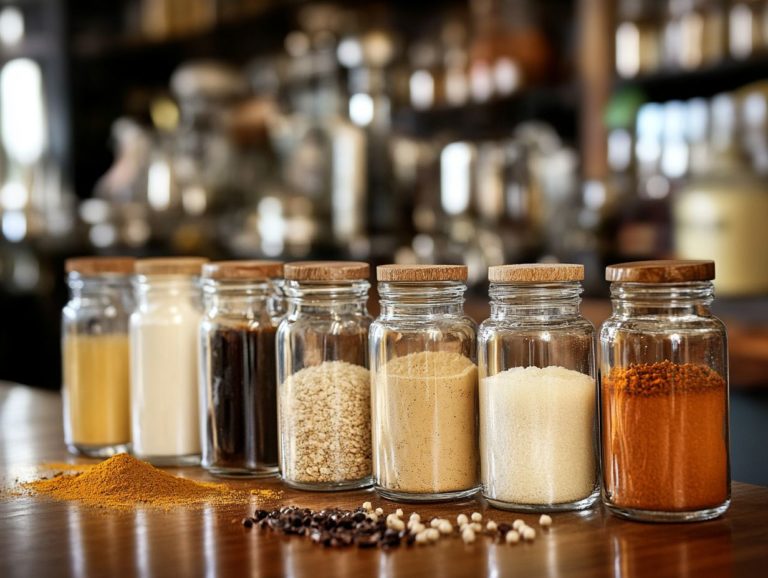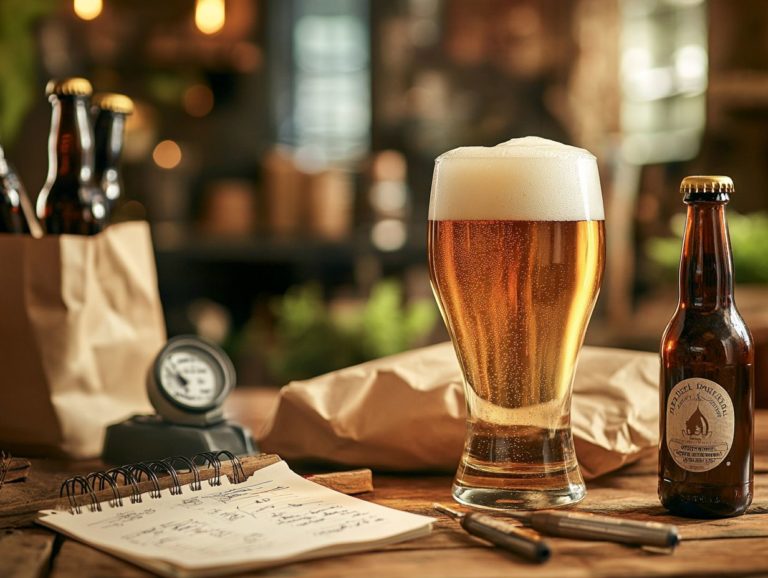Common Issues with Kegging Home Brew
Home brewing is a rewarding hobby that empowers you to craft your own unique beers. Kegging has emerged as a favored method for storing and serving that liquid gold. Whether you re using a kegerator or a traditional keg system, the process involves careful monitoring of pressure and temperature to ensure the best results.
This guide delves into the essentials of home brewing and kegging, highlighting the numerous advantages that kegging can provide. However, kegging does come with its own set of challenges. You may encounter issues such as leaky kegs, gas leaks, or carbonation mishaps. Fear not this guide will address these common hurdles faced by home brewers and offer valuable tips on how to prevent them. We ll also cover the importance of using a pressure regulator and maintaining your beer line to ensure smooth operation.
If you re aiming to elevate your brewing experience, act now! This guide equips you with the knowledge to troubleshoot effectively and savor every drop of your creation.
Contents
- Key Takeaways:
- What Is Home Brewing?
- What Is Kegging?
- What Are the Benefits of Kegging Home Brew?
- Conclusion
- What Are the Common Issues with Kegging Home Brew?
- 4. Foamy Beer
- 5. Off-flavors
- 6. Sanitation Issues in Homebrew
- How Can These Kegging Issues Be Prevented?
- When Should I Seek Professional Brewing Help?
- Frequently Asked Questions
- What are common issues with kegging home brew?
- How can I prevent overcarbonation in my kegged homebrew?
- Why is my kegged homebrew pouring with too much foam?
- How can I troubleshoot gas leaks in my kegging system?
- What can cause off-flavors in kegged homebrew?
- How often should I clean and maintain my kegging and draft beer equipment?
Key Takeaways:
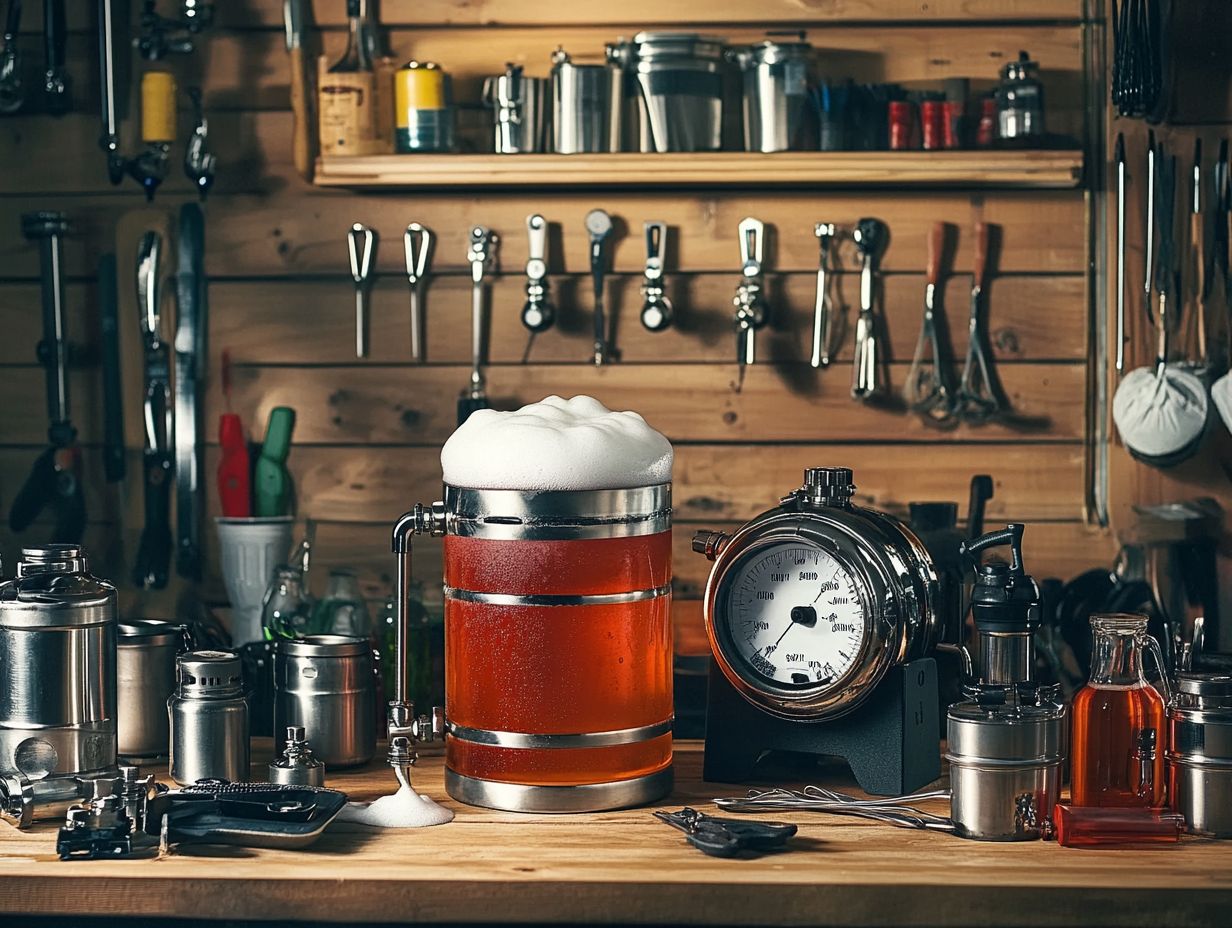
What Is Home Brewing?
Home brewing is the art of crafting beer on a smaller scale, often right in the comfort of your own home. This hobby allows you to explore a world of diverse beer styles, tailoring flavors to suit your individual palate.
As you master the brewing process, you ll find yourself experimenting with fermentation temperatures and gravity readings. This helps achieve just the right alcohol content and clarity in your creations. Monitoring your original gravity and final gravity ensures optimal results. You’ll also discover that having the right brewing equipment can make the journey even smoother, transforming your brewing endeavors into a truly rewarding experience.
What Is Kegging?
Kegging is the art of transferring your homebrew beer from fermentation vessels into kegs. This method elevates your brewing experience by making it easier to store, add bubbles, and serve your beer. With a kegerator at your disposal, you can meticulously control the pressure and temperature of your beer, ensuring it stays fresh and flavorful.
Understanding the nuances of your keg setup and the keg filling process significantly impacts the quality of your final product. The kegging process requires careful attention to the carbonation levels. This is often achieved with CO2, enhancing the taste and overall drinking experience. Proper keg maintenance and cleaning are essential to prevent contamination and maintain the integrity of your beer.
What Are the Benefits of Kegging Home Brew?
Kegging your homebrew opens up a world of exciting benefits that can truly elevate your brewing experience and enhance the overall quality of your final product.
One of the standout benefits is the ability to serve draft beer, which typically offers superior clarity and flavor retention compared to bottled alternatives. With kegging, you gain precise control over serving pressure and carbonation levels, allowing you to find that perfect balance between a flat pour and a frothy head.
Moreover, maintaining a keg is often far more straightforward and efficient than the bottling process. This encourages you to craft and savor your favorite beer styles more often. However, understanding both the pros and cons of kegging is crucial to making the best choice for your homebrew setup.
Conclusion
In summary, kegging not only simplifies the serving process but also enhances the quality of your homebrew. By taking the time to understand the techniques and tips outlined in this guide, you can embark on a rewarding brewing journey. So gather your equipment and start kegging your homebrew today!
What Are the Common Issues with Kegging Home Brew?
Kegging homebrew certainly has its perks, but it can also introduce a variety of common challenges that you might face during the process. Issues such as flat beer, foamy beer, and gas leaks can emerge from improper keg setup or insufficient cleaning.
Brewing inconsistencies can also arise, like overcarbonation or undercarbonation, resulting in off-flavors that detract from your overall drinking experience. To truly elevate your home brewing game, it s essential to grasp keg troubleshooting techniques and tackle any sanitation concerns. This way, the quality and consistency of your beer remain top-notch.
Leaky Kegs
Leaky kegs present a common challenge that can lead to significant headaches for brewers. These leaks can result in gas leaks, carbonation loss, and wasted beer.
Identifying the source of the leak is vital for maintaining effective keg cleaning procedures and ensuring proper keg maintenance. Leaks can stem from various issues, such as worn o-rings, faulty couplers, or even the tiniest cracks in the keg itself.
If you let a leaky keg go unchecked, it not only creates a disappointing experience for your customers but also impacts your brewery’s bottom line due to product loss.
When you encounter this problem, start troubleshooting with a thorough visual inspection of the keg. Examine all fittings and seals for any signs of wear. A simple solution of soapy water can be your best friend here just look for tiny bubbles that reveal the leak’s location.
Fixing leaks quickly not only saves your brew but also keeps the excitement alive for every sip!
Overcarbonation
Overcarbonation is a common hurdle for home brewers, leading to excessively foamy beer that s not only challenging to serve but also diminishes the enjoyment of your hard work.
Striking the right serving pressure and figuring out how to add carbonation are crucial steps in preventing this dilemma. When your beer becomes overcarbonated, it can result in a sharp, overly effervescent mouthfeel that overshadows the carefully crafted flavors and aromas you ve worked hard to develop.
This imbalance can also lead to a messy pour, wasting your precious brew and frustrating those eager to indulge in your creation. The culprits behind overcarbonation often include:
- Excess priming sugar
- Improper fermentation temperatures
- Faulty keg pressure settings
To sidestep these pitfalls, you should meticulously measure sugar additions, control fermentation conditions, and regularly monitor keg pressure to maintain optimal carbonation levels. Utilizing carbonation calculators can also be helpful in achieving the desired carbonation method.
By focusing on these details, you can significantly enhance your beer s flavor profile and ensure a more satisfying serving experience for yourself and your guests.
Undercarbonation

Undercarbonation occurs when your homebrew beer falls short on carbonation, leaving you with a flat brew that lacks the invigorating qualities many enthusiasts crave.
This issue often arises from improper kegging techniques or a carbonation method that doesn t quite hit the mark. When you encounter undercarbonation, you may notice how it really takes a toll on the drinking experience the absence of bubbles can diminish aroma, mouthfeel, and overall enjoyment.
This predicament might also stem from:
- Insufficient priming sugar
- Temperature fluctuations
- Too much CO2 absorption
To tackle these challenges and elevate your beer s profile, it s essential to adopt effective strategies. Focus on maintaining optimal fermentation temperatures, using the right priming methods, and fine-tuning serving pressures.
Regular checks with carbonation calculators can also be beneficial. By grasping the nuances of undercarbonation, you can ensure a more gratifying experience for everyone who appreciates the craft of beer tasting.
Ready to tackle these kegging issues? Let s dive into troubleshooting together!
4. Foamy Beer
Foamy beer often arises from overcarbonation or improper serving pressure, leading to an experience that may not sit well with those who appreciate a perfectly balanced pour. Understanding the science of carbonation and your keg setup can help you navigate this common challenge during the kegging process.
Factors such as temperature, beer style, and even the type of glass you use can significantly influence foaming issues. When the temperature climbs too high, carbon dioxide becomes less soluble, resulting in an abundance of foam upon pouring. Some beer styles are naturally more carbonated, which can further exacerbate the foamy pour. Clogged dip tubes can also contribute to excessive foaming.
To master the art of the perfect pour, it’s essential to maintain proper serving pressure and temperature control.
Utilizing specific glassware designed to minimize foam or adjusting the keg s pressure settings can greatly enhance your drinking experience. This allows you to savor a beautifully crafted beer without the annoyance of excessive head, ensuring each sip is as enjoyable as it should be.
Summary: To avoid foamy beer, control your serving pressure, temperature, and choose the right glassware.
5. Off-flavors
Off-flavors in your homebrew can significantly diminish the quality and enjoyment of your beer. These flavors often arise from fermentation issues (the process where yeast converts sugars into alcohol), infected yeast, or lapses in sanitation during the kegging process. Identifying the root cause is essential for enhancing your future batches.
These undesirable flavors can present themselves in various unpleasant ways. For instance, diacetyl imparts a buttery aroma, while acetaldehyde can taste like a green apple. Such issues often result from insufficient fermentation time or temperature fluctuations that stress the yeast.
To prevent these problems, ensure fermentation takes place within the recommended temperature range and allow for sufficient conditioning time (the time needed for flavors to mature). Using yeast nutrients can help foster a healthier fermentation process.
Make proper sanitation techniques before kegging a priority. Any lingering bacteria can lead to off-flavors, undermining the integrity of your final product. Regularly cleaning your brewing equipment and understanding the importance of water chemistry and hop varieties will further enhance your brewing process.
Summary: Control fermentation conditions, use yeast nutrients, and prioritize sanitation to prevent off-flavors.
6. Sanitation Issues in Homebrew
Sanitation issues pose a significant challenge for home brewers, as unwanted microorganisms can undermine both the clarity and overall quality of your beer. This can particularly affect the yeast during brewing. Make keg cleaning a priority to ensure top-notch beer quality!
Neglecting proper sanitation can lead to off-flavors, spoilage, and issues like acetaldehyde, resulting in a brew that fails to meet your expectations. Effective cleaning techniques such as using a no-rinse sanitizer and meticulously scrubbing and rinsing all brewing equipment can greatly enhance your final product’s clarity and flavor.
Regularly inspect and replace seals and gaskets to maintain a sanitary environment, ensuring that nothing compromises your efforts. This attention to detail is crucial in kegging setups. Remember that the brewing process is sensitive; even slight lapses in sanitation can disrupt fermentation.
Don’t risk your hard work prioritize sanitation to enjoy the best brew possible! By making sanitation a priority, you not only protect your investment in ingredients but also significantly enhance the enjoyment of the final beer.
Summary: Adopt effective sanitation practices to prevent contamination and enjoy high-quality homebrew.
7. Clogged Lines and Blockages
Clogged lines, especially those caused by a blocked dip tube in the keg, can significantly disrupt the flow of your beer. This can lead to frustrating serving issues and affect the beer’s clarity. To ensure a seamless beer dispensing experience, regular keg maintenance, including cleaning the beer line, is essential.
When debris or sediment builds up, it can create blockages that hinder the beer’s journey from the keg to the tap. This buildup not only results in uneven pours but can also lead to complete stoppages. Such issues compromise the quality of the beer served and contribute to increased waste and unhappy patrons.
Don’t let disruptions ruin your brewing experience schedule regular cleanings now! Prioritize regular cleanings and inspections of your entire dispensing system to ensure the beer line is clear and sediment-free. By utilizing appropriate cleaning solutions and adhering to manufacturer guidelines, you can effectively prevent potential clogs and maintain the quality of your draft beer.
Should issues arise, addressing the blocked components immediately is crucial for a swift resolution. This ensures that your patrons can enjoy their beer without any unwelcome delays.
8. Challenges in Achieving Proper Carbonation
Many home brewers grapple with the nuances of carbonation. This often leads to unpredictable results in their beer, such as flatness or excessive fizziness. By utilizing CO2 effectively and employing tools to measure carbonation, you can achieve your desired carbonation levels with remarkable precision, ensuring your beer meets your expectations.
You might face challenges like fluctuating temperatures, miscalculated sugar measurements, or inadequate pressure settings. These issues can easily lead to over-carbonation or under-carbonation in the brewing process, ultimately affecting the final gravity of your beer. To navigate these challenges adeptly, relying on trustworthy carbonation calculators and understanding the appropriate carbonation methods becomes essential.
These handy tools allow you to input variables such as batch size, desired carbonation level, and temperature, guiding you to the exact amount of priming sugar you need to add.
You can also tap into resources like brewing forums and guides for valuable insights and tips. These resources can help clarify the carbonation process, ensuring that each batch gets you one step closer to brewing perfection.
How Can These Kegging Issues Be Prevented?
To prevent common issues with kegging your homebrew, adopt a proactive approach that prioritizes thorough cleaning, precise carbonation levels, and meticulous temperature control, along with regular keg maintenance.
By recognizing the significance of regular keg maintenance and employing effective storage techniques, you can greatly enhance the quality and consistency of your beer. This approach helps prevent issues like gas leaks and foamy beer.
1. Proper Cleaning and Sanitation in Brewing

Proper cleaning and sanitation are essential for your brewing success. They ensure that your brewing equipment remains free from unwanted microorganisms and residues that can disrupt the fermentation process. Regarding kegging, establishing a thorough routine for keg cleaning is paramount, as it sets the stage for high-quality beer.
Begin your routine by disassembling the keg and rinsing it thoroughly with hot water to eliminate any lingering beer and sediment. Next, apply a suitable cleaning solution and allow it to rest for a specified duration to tackle any stubborn residues. After giving the internal surfaces a good scrub, rinse again until no traces of the cleaning agent remain.
Now, don’t overlook the sanitation stage this is where the magic happens! Using a food-safe sanitizer, like Star San, will ensure that even those surfaces that may not look dirty are completely safe for brewing. Your meticulous attention to hygiene throughout the kegging process can profoundly influence the flavor and quality of the final product.
2. Achieving Accurate Carbonation Levels
Achieving accurate carbonation levels is essential for crafting a well-balanced beer that aligns with your expectations, avoiding both over-carbonation and under-carbonation. By employing the right carbonation methods and utilizing tools like carbonation calculators, you can meticulously fine-tune your CO2 levels for optimal results, ensuring your beer’s carbonation is just right.
Consider investing in a reliable pressure gauge and a carbonation stone. These tools facilitate even distribution of CO2 throughout your brew, enhancing the carbonation process. Familiarize yourself with various carbonation techniques, such as force carbonation and natural fermentation, depending on the beer styles you prefer.
Calculating the precise amount of priming sugar and adjusting the pressure settings in your keg system is crucial for achieving a consistent finish. Monitor the temperature during the carbonation process, as warmer liquids absorb CO2 more efficiently than colder ones.
By combining these methods and tools, you ll be well on your way to achieving that perfect level of fizziness. This will ultimately enhance your overall brewing experience.
3. Proper Storage and Temperature Control for Kegging
Proper storage and temperature control are essential elements of kegging that directly influence the clarity and quality of your beer. Maintaining an appropriate storage environment prevents spoilage and off-flavors while preserving the intended characteristics of your brew.
Keep your kegs in a cool, dark place, ideally between 36 F and 40 F (2 C to 4 C). Changes in temperature can lead to inconsistent flavors and potential spoilage, which could ruin an otherwise exceptional batch. Store your kegs upright to prevent sediment disturbance, ensuring a clear pour.
Avoid excessive exposure to light, as UV rays can trigger reactions that produce undesirable tastes. Following these best practices protects your beer and lets those flavors shine!
4. Regular Maintenance and Replacement of Keg Parts
Regular maintenance and timely replacement of parts are essential for ensuring the longevity and effectiveness of your keg system, including the pressure regulator and beer tap. By routinely checking the kegerator, pressure regulator, and other components, you can prevent issues such as gas leaks and guarantee a seamless kegging experience.
Establishing a comprehensive maintenance routine not only extends the life of your brewing equipment but also elevates the quality of the beverages you serve. Key tasks on your maintenance checklist include:
- Cleaning the beer line regularly
- Inspecting and cleaning keg couplers
- Verifying the integrity of seals and gas lines
- Monitoring the temperature settings of the kegerator
- Checking carbonation levels
- Ensuring that tap lines are free of debris or blockages
By keeping a vigilant eye on these components, you can significantly reduce downtime and avoid costly repairs. This will ultimately lead to a superior product and enhanced customer satisfaction.
Start implementing these tips today for the best brewing results!
When Should I Seek Professional Brewing Help?
Seeking professional help can be a savvy move for home brewers grappling with persistent kegging issues that compromise the quality of their beer. If your attempts at troubleshooting have led to more frustration than resolution like persistent off-flavors or inconsistent carbonation consulting an expert can unlock valuable insights that will transform your brewing experience!
You may find yourself feeling overwhelmed by complex keg systems or the challenge of maintaining best serving temperatures. Enlisting a professional not only eases the burden but also enhances your overall brewing experience.
Expert advice can lead to tailored solutions that specifically address your unique brewing needs, ensuring that the final product meets your expectations. Professionals can introduce innovative techniques and technologies that might be off your radar, providing fresh perspectives that can save you time and minimize waste.
Ultimately, investing in professional assistance can elevate your brewing craft, resulting in a superior beverage and a deeper sense of satisfaction.
Frequently Asked Questions
What are common issues with kegging home brew?
Some common issues with kegging home brew include overcarbonation, foamy pours, leaks, and off-flavors. Regular maintenance and understanding the original and final gravity of your brew can help mitigate these issues.
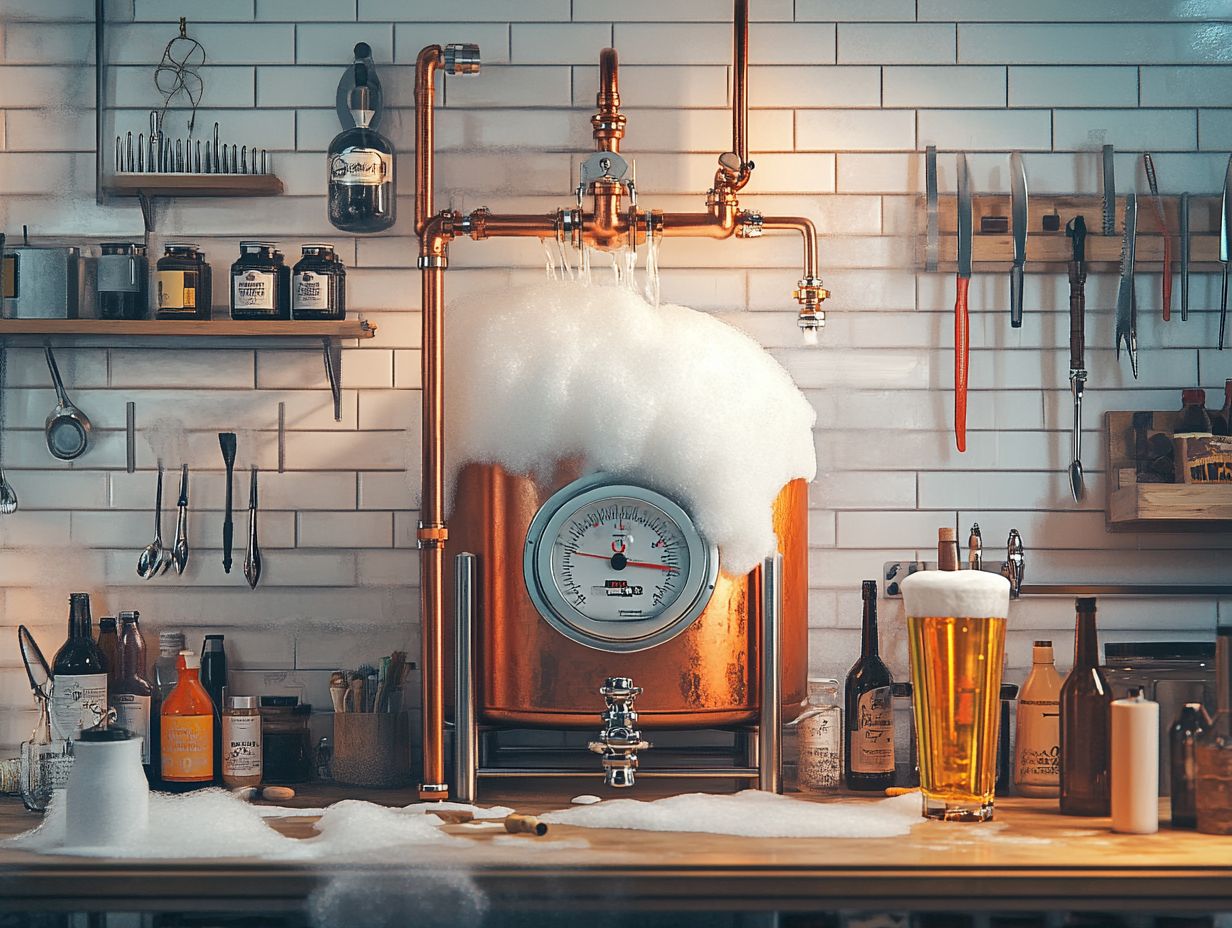
How can I prevent overcarbonation in my kegged homebrew?
To prevent overcarbonation, make sure to properly calculate and add the correct amount of priming sugar before kegging. You can also use a carbonation chart to determine the correct amount based on the style of beer, temperature, and carbonation method.
Proper yeast nutrients and gravity readings should also be considered.
Why is my kegged homebrew pouring with too much foam?
This could be due to several reasons, such as serving pressure being too high, beer lines being too warm, or dirty dispensing equipment. Make sure to properly balance your system using a pressure regulator and keep all equipment clean to prevent foamy beer pours.
Kegerator temperature and beer clarity are also important factors.
How can I troubleshoot gas leaks in my kegging system?
Check all connections and make sure they are properly tightened. If the leak persists, try replacing any worn or damaged o-rings or gaskets.
You can also use a soapy water solution to identify where the gas leak is coming from. Proper keg maintenance and checking the keg system setup can also help prevent issues.
What can cause off-flavors in kegged homebrew?
Off-flavors can be caused by improper cleaning and sanitizing of brewing equipment, contamination during the brewing process, or oxidation. Make sure to thoroughly clean and sanitize all equipment, practice good brewing techniques, and minimize exposure to oxygen during transfer and storage.
It’s also important to monitor fermentation temperature and water chemistry.
How often should I clean and maintain my kegging and draft beer equipment?
It is recommended to clean and sanitize your kegging equipment after every use to prevent any build-up of bacteria or off-flavors. Regular maintenance, such as replacing worn o-rings and cleaning beer lines, should also be performed to ensure the best quality of your homebrew.
Clean the beer tap and inspect the dip tube for clogs to maintain the system. Understanding kegging pros and cons can also be beneficial.

